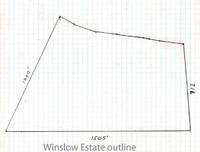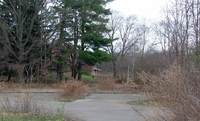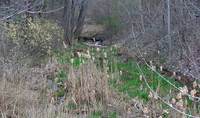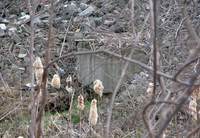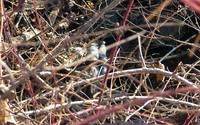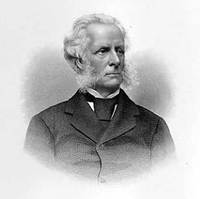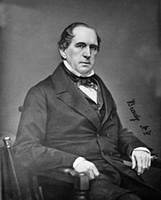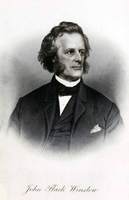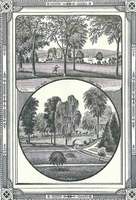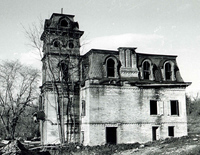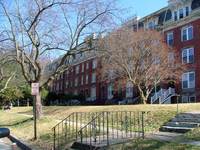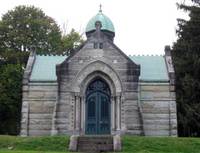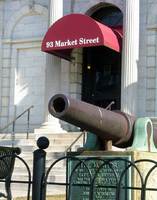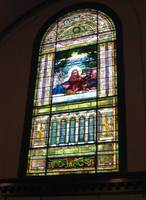Wood Cliff Estate (John Flack Winslow)
I first became aware of the name John Winslow in 2007 when I was researching deeds connected to Marist college land. There is a growing tradition for the women’s basketball teams to gather in early March at Shadows on the Hudson in their uniforms to watch the ESPN announcements of where and whom and when they will play in the NCAA basketball tournament. During this event I met William Kuffner from Buffalo, the twin brother of Dan Kuffner of Hyde Park. Both young men had graduated from Marist College in 1968. During our conversation Bill asked me what I was doing. I responded that I was hoping to find information about a man named John Winslow. Bill said: "You mean John Flack Winslow. I wrote my senior thesis on him for Brother Edward Cashin! “ Later Bill sent me a copy of his 1968 thesis; this became the starting point for my future research about Winslow (see note 1).
Winslow Estate
The Winslow estate lies between Route 9 and the Hudson River. Its northern boundary is a rock wall still visible, marking the southern boundary of Fern Tor, the Newbold estate. In 2012 it includes the former Dutchess bank building, the Fontaine academic building, the Gartland Commons student housing and the Gartland athletic fields. None of the Winslow estate structures still exist.
Winslow Farm
The Winslow farm stretched between Route 9 and Violet Ave. Its southern edge abuts the Home Depot and Mobil gas station. There is a street sign at the yellow caution light marked Winslow Gate Road. Directly north of the Winslow farm was a similar rectangular parcel owned by the Ziegler family. John and Harriet Winslow operated a farm on this parcel but also provided housing for their employees. The Ziegler and Winslow farms were part of an extensive farm owned by the Pells family. Later it was sold to Cyrus Mason who sold to John Corlies. In 1863 John Corlies sold 76 acres to Elias Van Benschoten who sold it in 1866 to William Ziegler. The Ziegler family held onto it until it was purchased by the State of New York in 1904 (see note 2).
The Winslow farm consisted of two packages: Winslow purchased the portion near Violet Avenue in 1871, and 1877 he purchased 27 acres near Route 9. The Poughkeepsie and Eastern RR tracks crossed this parcel in two places. Harriet Winslow transferred the entire farm to the Hudson River State Hospital in 1912 (see note 3).
In the next few decades the Winslow farm may play an important role in the development of Marist College and future housing plans for the former Hudson River State Hospital grounds.
One plan under consideration is to restrict traffic from the hundreds of homes planned on the hospital grounds from entering Route 9 from the existing entry road. The state hospital did little or no construction on the Winslow site, so a cost effective plan is to build a connector road between Route 9 And Violet Ave. (route 9G) on the Winslow farm property. The road would exit at the blinker light on Route 9. The existing traffic signal between Marist College and Office Depot would be transferred to the blinker site. Marist would relocate its North entrance onto the Fern Tor property. Currently plans for major housing on the state hospital property are on hold until the national housing situation improves.
John Flack Winslow: Life before the Monitor
John Flack Winslow was born November 10, 1810 to Captain Richard Winslow of Lyme CT and Mary Corning Seymour of Hartford CT. He was born in Bennington VT where his parents lived there, and then moved to Albany NY where his father Captain Winslow worked as a ship’s captain until his retirement. John worked for four years as a commercial clerk at the W and A Marvin Company of Albany. He received a commission to go to New York City as a trainee at the City Iron Company. He then went to New Orleans to establish a subsidiary company, but lasted there only a year because of the stifling weather conditions. He became the managing agent of the New Jersey Iron Company. In 1832 he met and married Nancy B Jackson, daughter of a prominent businessman from Rockaway NJ. During his four year stay in New Jersey, he met Erastus Corning who later became his partner in Troy NY.
Winslow and Corning formed an iron company named Corning and Winslow, but later the Rensselear Iron Company, soon to become the largest railroad iron manufacturer on the east coast. They took in a third partner, John A Griswald in 1840. By 1845, the renamed Albany Iron Works became the nation’s second leading manufacturer of railroad iron. In 1852, Winslow traveled to England and returned with the rights to manufacture iron made by the Bessemer process. The company soon vaulted into the first position in manufacture of railroad iron (see note 4).
John Winslow and his wife lived in Troy NY, where he became active in Republican politics. When Abraham Lincoln was elected President, John was named an official Elector. He decided to go to Washington for a few weeks to meet President-elect Lincoln personally.
Monitor Construction (see note 5).
While in Washington, Winslow met John Ericsson, who was crestfallen after he had made a proposal to the Navy Board for an ironclad warship with a revolving turret. The Navy Board had derided the idea, suggesting that the boat would sink as soon as it was launched. Winslow asked to see Ericsson’s plans, and spent a few weeks reviewing them. He became convinced that the plans had merit, and decided to intercede with Lincoln himself to approve the construction. A meeting was arranged with the Navy Board, Ericsson, Winslow, Griswold, C.S. Bushnell (a Massachusetts capitalist from Boston and advisor to Ericsson) and Lincoln. After listening to the presentation, Lincoln approved construction of such a vessel. But the terms were difficult: the vessel had to be completed in 100 days, and payment would be made upon completion.
Winslow’s management skills now came into play. Instead of using only the Albany Iron Works, he parceled the work out to several iron manufacturers. Winslow visited each one to specify exactly what that company was to build, and indicated that the completed iron be shipped to the Brooklyn Navy Yard, where he had authorized another company to build the wooden substructure. To the amazement of his critics, the ship (named the Monitor) was ready in 101 days!
During the trial runs of the Monitor, it was decided to scrap the original size cannon for much larger ones. Another snag was that a patent for a revolving turret has been granted to Theodore Trembly of Pawling NY in 1843. Winslow overcame this by promising to pay Trembly $5,000 for any turret manufactured by Albany Iron Works.
Note that Winslow, Griswald and Bushnell provided the interim financing of $275,000 for construction of the Monitor until they were reimbursed by the United States government, which happened after the classic battle of the Monitor versus the Merrimac, so an interesting trivia about the battle was that the North was represented by a privately owned vessel!
During the construction period, John Winslow’s wife Nancy became seriously ill, and died on December 19, 1861.
For his part in getting the Monitor built, Winslow was given the privilege of naming the Captain. He named John Lorima Worden of Pawling NY who in turn picked a crew of five men.
Within a year of the famous battle, thirty five other vessels were constructed using the plans for the Monitor. They were used to patrol and protect rivers and harbors, as the Monitor design proved not to be seaworthy.
Prior Owners of Winslow Estate
Frederic Barnard of Nantucket was a retired whaling ship captain. He purchased a 104 acre farm along the Hudson River and moved to Poughkeepsie with his wife and several of his eventual twelve children (see note 6). Within two years he sold the northernmost strip of the farm to Elijah Martin (see note 7). The Barnards lived there until 1837 when Frederic Barnard sold the remainder of the farm to Walter Cunningham, with Barnard holding a mortgage on the farm. About the same time, Barnard purchased two lots along Cannon Street that became the site of a large Barnard family house (see note 8).
Schoonhoven/Crosby Ownership (1847 – 1867)
Walter Cunningham sold the upper section to Henry C Richards. Henry C Richards also purchased the farm of Elijah Martin (see note 9). Henry Richards died shortly thereafter, and the executors of his estate sold off the 27 northern acres (including the Elijah Martin parcel) to James Van Schoonhoven of Troy NY (see note 10). During the Schoonhoven ownership, the railroad took a path 924 feet long for its tracks (see notes 11-12). Schoonhoven was a prominent businessman and President of the Troy Savings Bank. In 1855 he sold the land to Elizabeth Maria (née Schoonhoven) Crosby, his youngest daughter (see note 13). Elizabeth and her family must have been living on the site since the 1847 purchase. The 1850 census shows her, her husband and one year old daughter with four servants; the 1860 census shows her husband, herself, and six children with four servants (see note 14). The name wood cliff probably originated at this time, referring to the steep drop-off still visible from the level of the Gartland Commons student housing to the Gartland athletic complex. James Van Schoonhoven died at his daughter’s home September 9, 1865, age about 84.
A sidebar can be found on the Internet concerning Edward N Crosby, Elizabeth’s husband. Samuel F. B. Morse lived at Locust Grove, just south of Poughkeepsie. Shortly after Abraham Lincoln issue the Emancipation Proclamation on 1 January 1963, Professor Morse published an essay or tract defending the institution of slavery. Morse was the son of a minister from New England, and based his defense of slavery on biblical sources. Edward took it on himself to publish a reply, which caused Morse to reply to the reply, which caused Edward to reply to the reply to the reply, the latter titled “Our country versus party spirit being a rejoinder to the reply of Prof. Morse by Edward N. Crosby.’ It was published 1863 by Platt & Schram, printers in Poughkeepsie. This illustrates that states rights versus the union was a more compelling cause than slavery for many Northerners. Elizabeth Crosby’s 1869 application for a passport describes her as widow (see note 15).
Edward Crosby died 7 June 1865 in Troy NY after a lingering Illness, as noted on the index file of deaths housed in the Adriance Library. It might explain how Winslow became interested in the site. Troy is a small enough city that prominent businessmen like Winslow and Van Schoonhoven would know each other.
John Winslow was aware of the Dutchess area also because his younger brother, James Winslow, a banker in New York City, purchased a 29 acre site opposite the Poughkeepsie Rural Cemetery reaching eastward to Beechwood Avenue (see note 16). When they were younger John Flack Winslow considered the possibility of joining James in the finance business, but opted instead to pursue the iron manufacturing business.
John Flack Winslow in Poughkeepsie
John Flack Winslow came to Poughkeepsie to retire. He was already a wealthy man, and gained wide recognition as the man who managed to get the Monitor built. His wife had died in 1861. Winslow was acquainted with Dutchess County before he moved to the county in 1867. His younger brother James had moved to Poughkeepsie with his family before 1960 and owned a farm along Beechwood Avenue. In 1850 the James Winslow family is listed as living in New York City. James was still in Poughkeepsie in the 1870 census, (see note 17) but his 1870 listing for New York City as a banker indicates that the Poughkeepsie home was a country home, as he occupied a residence between 35th and 36th street in New York City (see note 18).
John Flack Winslow was active in the Presbyterian Church, and became acquainted with Harriet Wickes, eldest daughter of the Presbyterian Minister. Winslow was 57 years old; Harriet Wickes was thirty years younger. The couple married and began to establish an estate and a farm and a family.
The estate property already was in nice condition, with the main house in stone near the highway. Winslow liked the emerging Victorian style of architecture, and surrounded the existing stone house with a wooden framework, adding a tall tower which would allow him and his visitors to gain a sweeping view of the Hudson River. There was a stream running through the property (see note 19). Winslow created several ponds as the stream ran through the estate; these provided water in dry periods and formed an elegant setting for walkways and carriageways. In one of the ponds there was a small island in the shape of the Monitor.
Although retired from the iron business in Troy, Winslow was only 57 and remained active in many facets of Dutchess County history. He was no stranger to Dutchess, although most of his work had been in the eastern sector of the County, near Amenia, Millerton, and Pine Plains. The railroad had run north through the Harlem Valley about ten years before construction of the railroad along the east bank of the Hudson. Winslow purchased some farms outright and obtained mining rights to several others. The railroad reached Chatham where it connected to a railroad from New England leading towards Albany and Troy, so it became a major carrier of iron ore from the rich deposits in the Harlem Valley. By contrast, Edvard Bech and his partners obtained most of their iron ore from East Fishkill, drawn in carts by oxen and along plank roads during inclement weather.
Poughkeepsie & Eastern Railroad
Winslow decided to construct a railroad from the northeast corner of Dutchess County leading across the county and joining the Hudson railroad near Edward Bech’s foundry, which had been relocated from Union Landing to a site just north of Hoffman Street.
We researched the deeds in 1867 and 1868 which provide a trail from Millerton through the towns of Pine Plains, Northeast, Stanford, Washington, Clinton, Pleasant Valley and the Town and City of Poughkeepsie to the Hudson River (see note 20). The approach to Poughkeepsie took it next to the Fallkill Creek along a path which now is the back road for St. Peter’s Cemetery. Called the Poughkeepsie & Eastern Railroad, it entered the city of Poughkeepsie at Smith Street, where space was reserved for storage of railroad cars and engines. It would have been impractical to head straight downhill to the river edge, so the path took a serpentine route. It u-turned north moving into what would become the Hudson River State Hospital, then u-turned once again to the south west, following a gradual path which entered the Hudson Railroad just north of Hoffman Street. The remains of the path are now owned by CSX, but the tracks have been removed (presumably to lower the tax rate). The last section of the path passes adjacent to the Marist College property where the McCann Athletic Center is located (just behind the McCann Baseball Field). The path runs under Route 9. On the east side of Route 9 it runs through Marist College property to behind the Staples store. Long range plans call for turning it into a hiking path, but currently attention is focused on connecting the Railroad Bridge to the rail trails headed towards Poughkeepsie from Hopewell Junction.
When I was a student at Marist College in 1947-1950, we had no idea of the history of the Poughkeepsie & Eastern. We called the section of tracks we observed the New York Central; we knew it carried paper to Western Printing Company and coal to the central heating plant of the Hudson River State Hospital. But it also had spurs leading to the foundry and slaughter house along Fulton Street and to Schatz-Federal plant which was a principal supplier of ball bearings to Ford Motor Company We were unaware that the original railroad carried passenger traffic from the eastern part of the county to Pleasant Valley as recently as 1937! (see note 21).
Although the Poughkeepsie & Eastern began operation in 1870, it did not survive the financial panic of 1873. It went into receivership, and then went through several cycles of ownership, often with name changes (although the name Poughkeepsie & Eastern reappeared in the late 1800s.) At one time it had a connector railroad leading to Rhinebeck, where developers planned on moving railroad cars by ferry across the Hudson to connect with the West Shore Railroad which had begun in 1881. John Flack Winslow was the President of the Poughkeepsie & Eastern for several years and the driving force behind its construction.
For several years he was the President of the company founded to design and finance the construction of the Poughkeepsie Railroad Bridge. He may have consulted in the design of the bridge, although his name is not mentioned in any reference I found. His major contribution may have been in attracting investors, as the construction was a private undertaking. The Winslow estate was useful for this purpose, as John Winslow and his wife Harriet were gracious entertainers, and the tower he had added during the construction of the wood exterior to the main house provided visitors with panoramic views of the Hudson and the proposed site of the bridge.
The Winslows loved to entertain. On the fourth of July, he would fire a small cannon at the stroke of midnight to celebrate the holiday. The tradition ended when shot from the cannon accidentally exploded a small tug boat moving down the Hudson. Fortunately no was injured, but to make up for this incident John Flack Winslow bought the company a new boat – and the tradition ended! (see note 22).
John Winslow was also active in other commercial and real estate activities. One interesting set of real estate activities was concerned with Eastman Terrace. Harvey G Eastman (1832 – 1878) founded a business college in Oswego NY in 1855, then transferred it to Saint Louis MO in 1858 and relocated it again in 1859 to Poughkeepsie NY, naming it Eastman Business College, where it became one of the largest commercial schools in the United States (see note 23).
Eastman served as Mayor of Poughkeepsie in the period 1871 – 1878; his term is noted for establishing a water treatment plant for a city notorious for its bad drinking water. The treatment plant took land from the site now occupied by Marist College. One of Eastman’s projects was to develop elegant housing similar to that of Washington Square in New York City. He chose a site adjacent to South Avenue bordered by Eastman Terrace and Montgomery Street. A building similar to that at the north edge of Washington Square between Fifth Avenue and Waverly Place was constructed along Eastman Terrace, but the square never got closed in. However several members of the Improvement Group (an informal group of leading citizens of Poughkeepsie; Matthew Vassar was an important member) purchased land along the other sides of the proposed square. Their homes along Garfield Street, which runs east of and parallel to South Avenue. now constitute a historical area. John Winslow purchased property, but when the venture faltered, he sold the parcel.
John Winslow lived at the estate on now Marist College property with his wife Harriet Wickes until his death on 13 March 1892. He is buried in Albany Rural Cemetery, Menands NY. After his death, Harriet Winslow (1837 – 1926) remained on the estate until she died 18 January 1926. She was buried in the Winslow mausoleum next to her husband. John Winslow and Harriet had two children. The older, Julia Wickes Winslow, died as a young person. She is listed in the 1870 census as a 2 year old, but not in the 1880 census. Another daughter, Mary Corning Winslow, was born 10 February 1873, married Clarence A Black 11 December 1895 lived for about two decades in Detroit, Michigan where her husband was a businessman and later a banker. The Blacks had one daughter, Ruth born about 1897. Later the couple moved to California, living in Santa Barbara and Monterey. In the 1870s the Winslows also adopted the son of Harriet Winslow’s sister in the 1870s. His birth surname was Williams, but he changed it to be known as Thomas Scudder Winslow (see note 24).
Harriet Wilkes Winslow
I was unable to find anything unflattering or negative about Harriet Wickes Winslow . She was well respected. A later travelogue depicting sightseeing cruises along the Hudson specifically noted the grand estates of Mrs. John Winslow and Mrs. Thomas Newbold (immediately north of the Winslow estate). She encouraged individuals to further their education. During his research on his senior thesis, William Kuffner met often with Dr. Paul Hasbrouck, the historian of the first Presbyterian Church. Dr. Hasbrouck told him that Mrs. Winslow had enabled him to pursue his bachelors, masters, and doctor degrees from Columbia University. When Kuffner thought this was unusual, Dr. Hasbrouck indicated that she provided similar assistance to many others. In 1909, four years after the Marist Brothers had purchased the property just south of the Winslow estate, a small house near the barn burned down during the night. Insurance covered part of the cost. Mrs. Winslow sent $50 to help out. In her will Mrs. Winslow left $1500 to Huron College (see note 25) $1500 to Park College (see note 26), and $2500 to Lincoln University (see note 27).
The Presbyterian Church on Market Street near Main Street burned down. Mrs. Winslow was a principal donor for construction of the church at the corner of South Hamilton and Cannon Street. Recently the church was sold to another denomination, and the Presbyterian presence remains in a church along route 55. She donated a large stained glass window to honor her late husband. It still remains in the South Hamilton Street church. Marist College presents its annual program of Christmas carols and readings in the church.
Towards the end of her life, Harriet stayed at 247 Church Street in the City of Poughkeepsie with Sophie Harris, who had joined the Winslow household shortly before John Winslow’s death, but remained during Mrs. Winslow’s last years. Sophie is listed in the annual city directories at that address until 1932, the year she died. The 1920 census lists Harriet living at WoodCliff, with Sophie her secretary and a nurse and two maids.
Owners after Harriet Winslow
Kem Plastic Playing Cards
Kem specialized in plastic playing cards which were hard to duplicate; its principal clients were casinos who wanted to discourage cheating. But Kem decided not to build a factory on the site; instead it purchased a parcel on Beck Place on the east side of Route 9 offered by Western Printing Company which kept some rights to some storage space in the building (see note 28).
Vincent Costanzi (see note 29)
Kem disposed of the Winslow estate property by selling it to Vincent Costanzi, a local contractor whose family lived on North Bridge Street in Poughkeepsie (see note 30).
Vincent Costanzi and his brothers were contractors who specialized in home and light industrial construction. Vincent acquired considerable construction equipment from the sales of war surplus materials by the United States Government after World War II (see note 31). Vincent’s brother Anthony began his separate business in Kingston NY. Vincent stored his equipment close to route 9, and the remainder of the property was unused. He demolished the Winslow house along route 9 (see note 32). In 1972 he sold the river half of the Winslow property to his brother Anthony (see note 33).
Frank Eberhard
About 1966 he had sold a small portion of the highway section for a Sun Oil service station, and in 1972 Victor Costanzi sold the remainder of the highway section to Frank Eberhard, a well-known contractor/developer (see note 34). Eberhard arranged several leases, the most important of which was to the Dutchess Bank & Trust Co for a free standing branch at the north east corner of the parcel (see note 35).
In 1992 the College purchased the parcel next to Route 9, but was obliged to honor the long term lease to Dutchess Bank, which lease expired about 2007 (see note 36). This made possible the construction of the Fontaine Academic Building and more capacious entrances and exits to route 9.
Remembrances in Poughkeepsie
One hundred and twenty years after John Flack Winslow’s death, there are few in Poughkeepsie who recognize his name or how he helped the Union to win the Civil War through his construction of the Monitor. William Kuffner cited three memorials to Winslow in his senior thesis. He indicated that two of the cannons replaced on the Monitor for larger cannon were located at the entrance to the Adriance Library and Veterans Square (on Clinton Street).
The cannon at the Adriance Library entrance is mounted on a more recent cement pedestal, but fits the description of the Monitor’s earlier cannons. It may also have been the cannon which almost sank the ferry boat during a July 4 celebration. Mary C W Black gave the cannon in 1926, which is the year the estate was sold to John Marian. Kuffner also wrote that the ship’s bell from the destroyer named after Admiral John Lorima Worden who captained the Monitor during the battle had been placed with the Poughkeepsie Naval Reserve Station. Unfortunately, the Naval Reserve Station was decommissioned in 1993, and the location of the ship’s bell is unknown. The cannon in Veterans Square is completely different, so any connection to the Monitor is tenuous.
Inside the former Presbyterian Church there is a large stained glass window dedicated to John Flack Winslow. As mentioned previously, Harriet Wickes Winslow was a major supporter of the construction of the new church, and there is a private chapel named after her. During the annual Advent event operated by Marist College, there are very few who are aware of the connection between Winslow and the Wood Cliff estate.
So for the average citizen of Dutchess County there is only a street sign just north of Marist College marked “Winslow Gate Rd” that was the entry to the Winslow farm. The road currently is a shortcut for southbound traffic on Route 9 to enter the shopping center with Home Depot and Staples as main tenants.
Sic transit gloria!
|
acquired |
owner |
disposed |
|
1984 & 1992 |
Marist College |
|
|
1972 |
Frank Eberhard |
1992 |
|
1977 |
Anthony Costanzi |
1984 |
|
1948 |
Vincent J Costanzi |
1977 |
|
1946 |
Kem Playing Cards |
1948 |
|
1934 |
Runk Realty Corp |
1946 |
|
1934 |
Wesley Ruthkowski |
1934 |
|
1934 |
Nicholas & Tempa E Dyruff |
1946 |
|
1929 |
Woodcliff Pleasure Park |
1934 |
|
1926 |
Fred Ponty |
1929 |
|
1926 |
John Marian |
1926 |
|
1867 |
John F Winslow |
1926 |
|
1855 |
Elizabeth Crosby |
1867 |
|
1847 |
James Van Schoonhoven |
1855 |
|
1844 |
Henry S Richards |
1847 |
|
1836 |
Walter Cunningham |
1844 |
|
1819 |
Elijah Martin |
1844 |
|
1817 |
Frederic Barnard |
1836 |
|
1813 |
Peter Morgan |
1817 |
|
|
Samuel Slee |
1813 |
Notes
Note 1. Senior thesis, 1968, William Kuffner JOHN FLACK WINSLOW submitted to Bro. Edward Cashin, Academic Vice President of Marist College, May 1, 1968. A substantial portion of his thesis was published in The Hudson River Valley Review, A Journal of Regional Studies, Spring 2012 pp. 94-104. The book by D. H. Wheeler is now available on the Internet. Google John Flack Winslow.
Note 2. Deeds to the Ziegler farm: 1869 liber 123 page 284 John W Corlies to Elias Van Benschoten; 1868 liber 143 page 575 Elias Van Benschoten to William Ziegler; 1904 liber 332 page 328 Freeman & Maria Ziegler to People of the State of New York.
Note 3, Deeds related to the Winslow farm: 1870 liber 155 page 73 Elias Van Benschoten to John F Winslow; 1871 liber 1259 page 290 Elias Van Benschoten to John F Winslow; 1877 liber 190 page 97 John F Winslow to James H Weeks; 1877 liber 190 page 99 James & Harriet Weeks to Harriet Wickes Winslow; 1912 liber 376 page 44 Harriet Winslow to People of the State of New York.
Note 4. The materials in this section as well as the Monitor Construction are based on William Kuffner’s thesis.
Note 5. My brief resume of the Monitor construction follows that of William Kuffner’s thesis, which in turn was based on the privately printed work of Rev. Francis Brown Wheeler, to whom John F Winslow dictated his memory of the events. In 1968 only two copies of this work were known to exist, one in the archives of the Presbyterian Church of Poughkeepsie, the other in the rare book room of the Adriance Memorial Library in Poughkeepsie N Y. Recently the book has been made available on the Internet at www.johnflackwinslow.com/ . The internet site also displays a 1944 article about the Winslows and a story of the auction of furnishings sometime in 1926.
Note 6. The farm was situated between Route 9 (then called the Highland Turnpike) and the Hudson River. Its southern border was approximately the Water Works Road on the Marist Campus.
Note 7. 1817 liber 26 page 41 Peter and Elizabeth Morgan to Frederic Barnard; 1819 liber 34 page 194 Frederic Barnard to Elijah Martin
Note 8. 1836 liber 61 page 141 Frederic & Margaret Barnard to Walter Cunningham; 1836 liber 61 p 139 Walter Cunningham to Frederic Barnard; 1837 liber 62 page 43 Walter Cunningham to Frederic Barnard.
Note 9. 1838 liber 63 page 345 Walter Cunningham to Henry C Richards; 1844 liber 78 p 85 Elijah & Anna Martin to Henry C Richards;
Note 10. 1847 liber 84 page 356 Henry C Richards dec’d to James Van Schoonhoven. The latter was born 1781.
Note 11. See deed liber 89 page 459 dated 17 June 1849 James Van Schoonhoven of Troy to Hudson River RR Co. The railroad took parcels 207 and 208 on the maps filed with the county records. Parcel 207 was 162’ and parcel 210 was 462 feet. The parcel was bounded on the north by land of John Pell and on the south by land now or formerly of Charles Trotter, and bounded on the east and west by lands of the grantor.
Note 12.
Note 13, 1855 liber 132 page 407 James Van Schoonhoven to Elizabeth M Crosby
Note 14. 1850 census NY_Dutchess County_Poughkeepsie Elizabeth Crosby
1860 census NY Dutchess County Poughkeepsie Elizabeth Crosby
Note 15. 1869 passport application of Elizabeth M Crosby dated 14 October 1869
Edward Crosby’s death is recorded in the index card file at the Adriance Library. The index files are locked in a separate room in the reference section, but can be accessed by asking the reference librarian. The usual listing books for obituaries did not begin until the 1970-1979 decade.
Note 16. See deed 7 July 1857 liber 109 page 604 Henry and Margaret M Stanton to James Winslow.
An earlier deed for the property 1 April 1850 liber 91 page 282 Nathan H Jewett to Henry Stanton
A companion deed $5725 for 35 acres next to the Winslow property was 1 April 1850 liber 91 page 281 Nathan H Jewett to Charles A Macy.
Note 17. US censuses: 1850_ny_nyc_james winslow; US census 1869_NY_dutchess_poughkeepsie_james winslow : 1870_ny_dutchess_poughkeepsie_james winslow; 1870_ny_nyc_james winslow.
Note 18. By 1860 Mrs. James Winslow was the President of the Sanitary Fair, a fund raising effort which took in $18,640 with expenses of $2,358 for a net of $16,282! See Platt’s History of Poughkeepsie, page 193.
Note 19. The stream is marked on then contemporary maps as originating in the northeast corner of the Ziegler farm, passing through the Winslow farm, running under the highway, then through the Wood Cliff estate and passing to the property to the south. In the Annals of St. Ann’s Hermitage 1904-1934, page 43, the narrator tells of providing a cement basin to receive the waters coming from the Winslow farm (1918). This later became a dam to provide hydroelectric power to the Marist Brothers’ property. The ravine carrying the stream and the conduit to under the highway are clearly visible near the Winslow gate.
Note 20. The proposed railroad also ran through Boston Corners, as did two other railroads. This was a small triangular parcel belonging to the state of Massachusetts but separated from the rest of the state by a ridge of hills. It became a hideout for the lawless, as enforcement was difficult by the Massachusetts police was difficult. The states of New York and Massachusetts agreed to transfer the triangle of land to New York. Shortly after the transfer there was a prizefight held there, that became known as the Boston Massacre. Some writers attribute the transfer of land to that fight, but the fight occurred after the transfer.
Note 21. The Pleasant Valley station was preserved and relocated to a school grounds. Current negotiations are to move it again to the Rhinebeck Fairgrounds, which hopes to set up an area containing historic elements.
Note 22. This incident is reported in William Kuffner’s senior thesis, Chapter III, page 14. Perhaps the cannon was the one donated to the City of Poughkeepsie by Mary C W Black, the Winslows’s daughter, which now stands guard of the front entrance to the Adriance Memorial Library on Market Street.
Note 23. Mary Travis, my first secretary when I became President of Marist College was a graduate; so was Sebastian Spering Kresge (1867 – 1966), founder of S. S.Kresge stores now known as K-Mart, K-Mart merged with Sears, Roebuck & Co in 2004. It is the third largest retailer in the United States.
Note 24. The Winslows also cared for Thomas’ sister Cordelia. She is listed as living with the Winslows in the 1892 New York State census, but kept the surname Williams.
Note 25. Huron College was founded in Pierre, South Dakota in 1883 as the Presbyterian University of South Dakota but was commonly called Pierre College. In 1897 it moved to Huron SD and became Huron College. It retained its Presbyterian affiliation until 1984. It has been taken over by several educational entities, as it encountered difficult financial problems.
Note 26. Park College was founded in Parkville, Missouri in 1875 on land on a bluff overlooking the Missouri river donated by George Park. For several years it was affiliated with the Presbyterian Church , but no longer has that affiliation,. It is now Park University and operates many programs for military bases using distance learning.
Note 27. Lincoln University, the nation’s first historically black university located in Oxford, Chester County, Pennsylvania was founded in 1854.
Note 28. 1946 liber 652 page 64 Runk Realty Company to Kem Playing Cards Inc.
Note 29. 1947 liber 655 page 183 Western Publishing Company to Kem Plastic Playing Cards Inc
Note 30. 1948 liber 681 page 605 Kem Plastic Playing Cards Inc to Vincent J Costanzi
Note 31. I remember seeing the equipment used to pull stumps from an old orchard near the main house on the Brothers property north of the Water Works Road. He did this free of charge. Later in the 1960s Costanzi worked at road construction and took a major contract in Putnam County for route 301 from route 9 to the Taconic Parkway. He underbid and was in serious financial trouble. Brother Nilus Donnelly remembering the many times Costanzi had helped the Brothers free of charge, offered Costanzi free access to sand and gravel banks on a property in Cold Spring which the Brothers had purchased for a new Juniorate.
Note 32. I learned this from the late Mary Reilly, who lived on a parcel she and her husband had purchased from Charles Chlanda. I had visited her to seek the location of the main house of the Newbold family,. She walked me outside to show me the foundations. Then she turned toward the Winslow property, pointed to a location along the road and said: “I saw Costanzi take that house down”. The Reillys lived on North Bridge Street, which street was also the location of the Costanzi family home.
Note 33. Recorded 1973 liber 1462 page 614 V J Costanzi Co to Anthony Costanzi
Note 34 1972 liber 1332 page 927 V J Costanzi Co to Frank Eberhard dba Kimco
Note 35. 1984 liber 1635 page 463 Anthony Costanzi to Marist College
Note 36. 1992 liber 1918 page 517 Trison Company to Marist College
Research on this project was conducted from January 2008 through August 2012 by Richard Foy, assisted by student assistants Paul Contarino and Kayla Benefield.
This is a list of deeds which are on file at the Dutchess County Office Building with the County Clerk (second floor). It was not thought useful to provide the full text here as it is readily available at the office of the County Clerk.
Deed Legend:
year=the year recorded with the clerk
date=date marked on the deed itself
liber=book in which deed is listed
page=page of the liber book
description=description of deed
grantor=individual or group originally holding deed
grantee=individual or group taking title to the deed
|
liber |
page |
Year |
description |
grantor |
grantee |
|
0 |
0 |
1845 |
|
Frederic Barnard |
James Van Schoonhoven |
|
0 |
0 |
1847 |
Wood Cliff property |
Frederic Barnard |
James Van Schoonhoven |
|
0 |
0 |
1866 |
cited by liber 332 p 328 |
Elias Van Benschootan |
Freeman, Maria, & Almira Zeigler |
|
0 |
0 |
1878 |
|
William Zeigler |
Benjamin Freeman & Maria Zeigler |
|
0 |
0 |
1985 |
title insurance North Property |
|
|
|
0 |
0 |
1986 |
lease Trison Company |
|
|
|
0 |
0 |
1986 |
Title property Trison Company |
|
|
|
0 |
0 |
1987 |
Lease Gas Station North property |
|
|
|
0 |
0 |
1992 |
statement of sale Finnerman/Trison Co |
|
|
|
|
|
|
|
|
|
|
|
|
|
Winslow Estate / Hudson River |
|
|
|
20 |
564 |
1813 |
104 acres betwn Pells & VanAnden |
Samuel Slee |
Peter B Morgan |
|
26 |
41 |
1817 |
$4,500 100 acres north of Van Anden land |
Peter & Eliz Morgan |
Frederic Barnard |
|
61 |
141 |
1836 |
$14,000 for 100 acres |
Fred & Margaret Barnard |
Walter Cunningham |
|
63 |
345 |
1838 |
Barnard Farm less Martin acres |
Walter Cunningham |
Henry S Richards |
|
84 |
355 |
1847 |
upper third of Barnard farm |
Henry S Richards via Benjamin Bonney |
James Van Schoonhoven |
|
89 |
459 |
1849 |
strip for railroad tracks |
James Van Schoonhoven |
Hudson River RR Co |
|
132 |
407 |
1855 |
$10,000 for 28 acres |
James Van Schoonhoven |
Elizabeth M Crosby |
|
141 |
647 |
1867 |
Crosby estate for $38,000 |
Elizabeth M Crosby |
John F Winslow |
|
34 |
194 |
1819 |
$327 small strip north 6± acres |
Frederic Barnard |
Elijah Martin |
|
78 |
85 |
1844 |
original Barnard 6 acres |
Elijah Martin & Anna wf |
Henry S Richards |
|
140 |
516 |
1867 |
6± acres |
Richards estate |
John F Winslow |
|
|
|
|
|
|
|
|
|
|
|
Winslow and Zeigler farms |
|
|
|
123 |
284 |
1863 |
$21,800 for 78 acres north Davies |
John W Corlies |
Elias Van Benschoten |
|
143 |
575 |
1866 |
56 acres north of Winslow farm |
Elias Van Benschoten |
William Zeigler |
|
202 |
396 |
1878 |
Zeigler farm |
William Zeigler |
Freeman Zeigler & wf |
|
332 |
328 |
1904 |
$12,000 for 56 acres |
Freeman & Maria Zeigler |
People of the State of New York |
|
156 |
88 |
1870 |
$1 land between Davies & Zeigler 66' x 563' |
Elias Van Benschoten |
P'k'sie & Eastern RR |
|
159 |
290 |
1871 |
27 acres east portion Winslow farm |
Eliaa VB vis Ferguson |
John F Winslow |
|
190 |
99 |
1877 |
27 acres near Albany Post Road |
James & Harriet Weeks |
John F Winslow |
|
140 |
513 |
1867 |
27+ acres for $40,000 |
John F Winslow |
Harriet Wickes |
|
376 |
44 |
1912 |
$10,00 Winslow farm to Hudson River State Hospital |
Harriet W Winslow |
People of the State of New York |
|
82 |
356 |
1847 |
confirms sale of 27 acres by Bonney |
Richards |
James Van Schoonhoven |
|
84 |
355 |
1847 |
27 acres by referee |
Benjamin Bonney |
James Van Schoonhoven |
|
89 |
459 |
1849 |
strip for railroad lines |
James Van Schoonhoven |
Hudson River RR Co |
|
123 |
284 |
1863 |
$21,800 fir 78 acres incl Winslow & Zeigler farms |
John W Corlies |
Elias Van Benschoten |
|
132 |
407 |
1855 |
$10,000 for 28 acres of Winslow farm |
James Van Schoonhoven |
Elizabeth M Crosby |
|
140 |
513 |
1867 |
27+ acres for $40,000 |
John F Winslow |
Harriet Wickes |
|
140 |
516 |
1867 |
Richards estate to J F Winslow |
Robert G Richards & ors |
John F Winslow |
|
140 |
647 |
1867 |
$38,000 27 acres |
Elizabeth M Crosby |
John F Winslow |
|
140 |
647 |
1867 |
Elizabeth is Van Schoonhoven's daughter $38000 |
Elizabeth Crosby |
John F Winslow |
|
143 |
575 |
1868 |
Zeigler farm north of Winslow farm 56 acres |
Elias Van Benschoten |
William Zeigler |
|
156 |
88 |
1870 |
$1 land between Davis & Zeigler 66' x 563' |
Elias H Van Benskouten |
P'k'sie & Eastern RR |
|
159 |
290 |
1871 |
East portion of Winslow farm 27 acres |
John Ferguson |
John F Winslow |
|
190 |
99 |
1877 |
27 acres of Winslow farm except P&E tracks |
James & Harriet Weeks |
Harriet W Winslow |
|
212 |
580 |
1882 |
|
John F Winslow & ors |
Wm C Smillie |
|
216 |
460 |
1884 |
|
John F Winslow |
John P Adriance |
|
218 |
286 |
1884 |
|
Irving Ellin, referee |
John F Winslow |
|
238 |
361 |
1888 |
|
John F Winslow |
John I Platt |
|
259 |
39 |
1891 |
|
John F Winslow |
Jacob Corlies |
|
332 |
328 |
1904 |
$12,000 56.21 acres to HRSH |
Benjamin Freeman & Maria Zeigler |
People of State of NY |
|
335 |
337 |
1904 |
right of way |
|
|
|
355 |
410 |
1907 |
|
Harriet & Thomas Winslow |
Charlotte P Wheeler |
|
376 |
44 |
1912 |
$10,000 Winslow farm to Hudson River State Hospital |
Harriet W Winslow |
People of the State of NY |
|
380 |
454 |
1913 |
land to add or widen tracks |
Harriet W Winslow Exr |
NYC & Hudson Rr Co |
|
457 |
70 |
1928 |
|
Fred H Ponty |
Central Hudson Gas & Elec Co |
|
465 |
492 |
1926 |
Wood Cliff property $24,500 |
Thomas Scudder Winslow |
John E Marian & wife |
|
475 |
250 |
1926 |
sale for Woodcliff Pleasure Park |
John B & Eliza Marian |
Fred H Ponty |
|
511 |
44 |
1929 |
WPP a holding company; Ponty from Rye NY |
Fred H Ponty |
Woodcliff Pleasure Park |
|
604 |
533 |
1935 |
by referee |
Woodcliff Pleasure Park Holding Co & ors |
Tempa E Dyruff |
|
604 |
566 |
1935 |
forcloses mortgage ml 380, p 40 |
Fred Ponty & ors |
Tempa E Dyruff |
|
604 |
570 |
1936 |
includes Western Printing land |
Dutchess Co Sheriff |
Tempa E Dyruff |
|
615 |
176 |
1944 |
Sun Oil Company property |
Lucy Ryan |
Vincent & Ethel A Morano |
|
634 |
224 |
1946 |
lease 200 x 200 parcel Woodcliff Parking Lot |
Tempa E Dyruff |
Arthur E Wheeler, |
|
635 |
437 |
1946 |
West Pub land south of J F Winslow |
Tempa E Dyruff |
Western Printing & Publishing |
|
652 |
64 |
1946 |
Winslow estate 27 acres |
Runk Realty Corp |
Kem Playing Cards Inc |
|
678 |
372 |
1947 |
|
Vincent & Ethel Morano |
Vincent & Gloria Morano |
|
681 |
605 |
1948 |
Winslow estate 27 acres |
Kem Playing Cards |
V J Costanzi |
|
1188 |
405 |
1965 |
|
D T Realty Inc |
Sun Oil Company |
|
1194 |
120 |
1965 |
Sun Oil Company property |
John Louty |
Herbert Redl |
|
1197 |
594 |
1966 |
Sun Oil Company property |
Ethel A Marano |
|
|
1332 |
927 |
1972 |
half adjoining Route 9 14.3 acres |
V J Costanzi Co |
Frank Eberhard Kimco Co |
|
1421 |
533 |
1975 |
Sunoco Service Station |
Frank Eberhard & Kimco |
Trison Co |
|
1462 |
614 |
1977 |
river half to his brother Anthony |
V J Costanzi Co |
Anthony Costanzi |
|
1572 |
305 |
1982 |
later owned by Trison |
Finnermans |
Crimswal Realty Co |
|
1638 |
463 |
1984 |
ball field section of Woodcliff |
Anthony Costanzi |
Marist College |
|
1659 |
591 |
1985 |
K Plaza - Gartland & Bank |
may be 541 |
|
|
1918 |
517 |
1992 |
6574 part of Costanzi property |
Trison Company |
Marist College |
Marist University | Marist Archives & Special Collections | Contact Us | Acknowledgements

